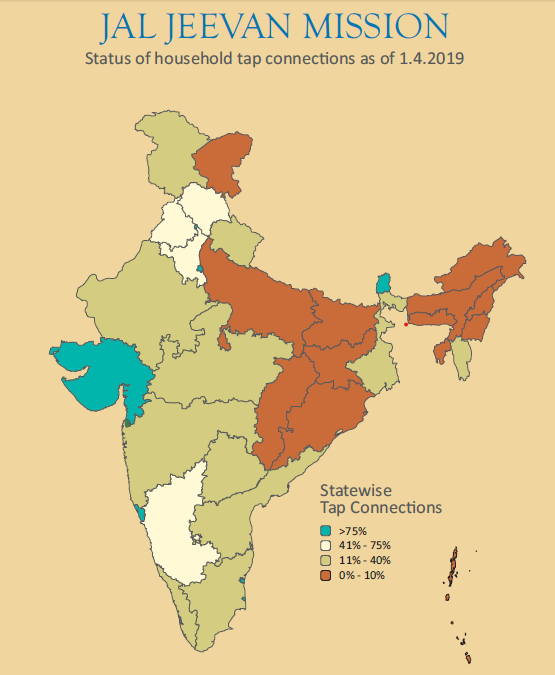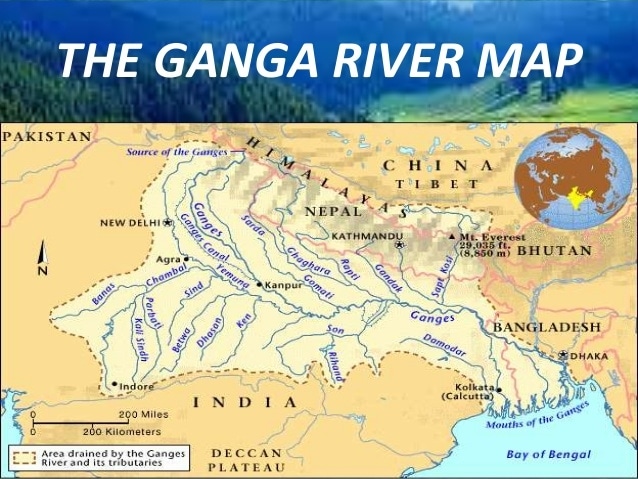Governance
Year End Review 2019: Ministry of Jal Shakti
- 20 Apr 2020
- 9 min read
Important Schemes and Policies
- The government has created a new Ministry called ‘Jal Shakti’ after merging Ministries of Water Resources, River Development & Ganga Rejuvenation along with Drinking Water and Sanitation.
- ‘Jal Shakti’ ministry will encompass issues ranging from providing clean drinking water, international and inter-states water disputes, to the Namami Gange project aimed at cleaning Ganga and its tributaries, and sub-tributaries.
- Namami Gange Programme is an Integrated Conservation Mission, approved as ‘Flagship Programme’ by the Union Government in June 2014 to accomplish the twin objectives of effective abatement of pollution, conservation and rejuvenation of National River Ganga.
- The program is being implemented by the National Mission for Clean Ganga (NMCG), and its state counterpart organizations i.e., State Program ManagementGroups (SPMGs).
- Aims to provide individual household water tap connection to every rural household in the country by 2024.
- It envisages supply of 55 litres of water per person per day to every rural household through Functional Household Tap Connections (FHTC) by 2024.
- The Scheme will be implemented through institutional mechanism at four levels- National, State, District, and Gram Panchayat, in which a major role will be played by women and the Paani Samitis or the user group.
Read More: The Big Picture- Ensuring Water Security
- It is a collaborative effort of the Central and State Governments to accelerate progress on water conservation activities in the most water stressed blocks and districts of India.
- The campaign aims to promote focused interventions for water collection and conservation, including restoration and renovation of traditional water bodies.
10 Year Rural Sanitation Strategy (2019-2029)
- Department of Drinking Water and Sanitation (DDWS), Ministry of Jal Shakti, has launched the 10 Year Rural Sanitation Strategy (2019-2029).
- It focuses on sustaining the sanitation behavior change that has been achieved under the Swachh Bharat Mission Grameen (SBM-G), and increasing access to solid and liquid waste management.
- The 10 year strategy focuses on the need for States/UTs to continue their efforts to sustain the gains of the mission through capacity strengthening, IEC (Information, education and communication), organic waste management, plastic waste management, grey water management and black water management.
- The Prime Minister chaired the first meeting of the National Ganga Council in Kanpur, Uttar Pradesh in December 2019.
- The meeting was aimed at reinforcing the importance of a ‘Ganga-centric’ approach in all departments of the concerned states as well as relevant Central Ministries.
- The Council has been given overall responsibility for superintendence of pollution prevention and rejuvenation of River Ganga Basin, including Ganga and its tributaries.
- The Government has set up the Clean Ganga Fund (CGF) to facilitate contributions from individuals, NRIs, corporate entities for funding Ganga rejuvenation projects.
National Mission for Clean Ganga (NMCG)
- NMCG is the implementation wing of National Ganga River Basin Authority (NGRBA).
- It is a registered society, originally formed by the Ministry of Environment, Forests and Climate Change (MoEFCC) on 12th August 2011 under the Societies Registration Act, 1860.
- However, both NGRBA and NMCG function under the Ministry of Jal Shakti.
- Main pillars of the programme include sewerage treatment infrastructure, river-front development, river-surface cleaning, bio-diversity, afforestation, public awareness industrial effluent monitoring, and ganga gram.
Flood Management and Border Areas Programme (FMBAP)
- FMBAP has been approved by the Union Cabinet.
- The FMBAP Scheme will be implemented throughout the country for effective flood management, erosion control and anti-sea erosion.
- The proposal will benefit towns, villages, industrial establishments, communication links, agricultural fields, infrastructure etc. from floods and erosion in the country.
- The catchment area treatment works will help in reduction of sediment load into rivers.
- It is a central sector scheme for sustainable management of groundwater with community participation.
- It envisages people's participation through the formation of ‘Water User Associations’, water budgeting, preparation & implementation of Gram-panchayat-wise water security plans, etc.
Important Facts
- By alleviating 60% of the world’s share of people defecating in the open, India has significantly contributed to the global achievement of SDG 6.
- The 6th India Water Week-2019 was observed from September 24, 2019. The theme of the India Water Week-2019 was ‘Water Cooperation – Coping with 21st Century Challenges.’
- The Ministry of Jal Shakti has been organizing India Water Week since 2012 as an international event to focus on water related issues.
- First HAM project in sewerage sector: Sewage Treatment Plant (STP) at Sarai in Haridwar has become the first Hybrid Annuity (HAM) Based Public Private Partnership Model STP.
Note:
Under Hybrid Annuity Model (HAM), the central government bears 40% of the project cost and the remaining amount is arranged by the developer. As per the design, the government contributes 40% of the project cost in the first five years through annual payments (annuity). The remaining payment is made on the basis of the assets created and the performance of the developer.
- ‘Ganga Aamantran Abhiyan’ is an open-water rafting and kayaking expedition on the Ganga River held in October-November 2019.
- Starting at Devprayag and culminating at Ganga Sagar, the expedition covered the entire stretch of over 2500 kms of the Ganga River.
- This is the longest ever social campaign undertaken through an adventure sporting activity to spread the message of River Rejuvenation and Water Conservation on a massive scale.
- MARVI Project: The Managing Aquifer Recharge and Sustaining Groundwater Use through Village-level Intervention (MARVI) project has developed a village-level participatory approach for measuring groundwater levels and improving water-use efficiency in groundwater-stressed regions of India.
- Farmers and other stakeholders are directly involved in the process. A unique feature of MARVI is the engagement of Bhujal Jankaars (BJs) meaning “groundwater informed”.
- These are volunteers who, with appropriate training and capacity building by the project team, monitor rainfall, groundwater levels and quality, and water levels of managed aquifer recharge infiltration basins (called check dams).
- They also make sense of the data from a village perspective and infer what can be done to improve the groundwater situation and household livelihoods, which are often based on growing crops with groundwater irrigation.
- Importantly, the BJs inform and guide villagers on the groundwater situation and how best to use groundwater in response to seasonal or long-term variability in resources.








